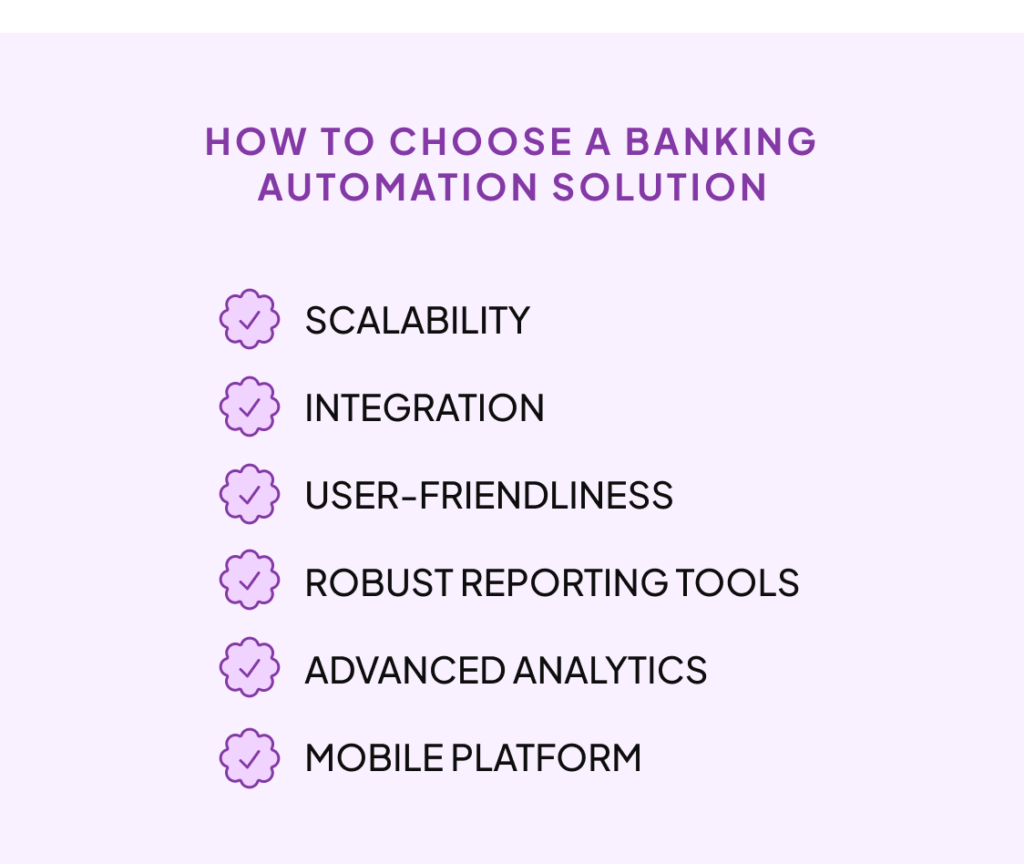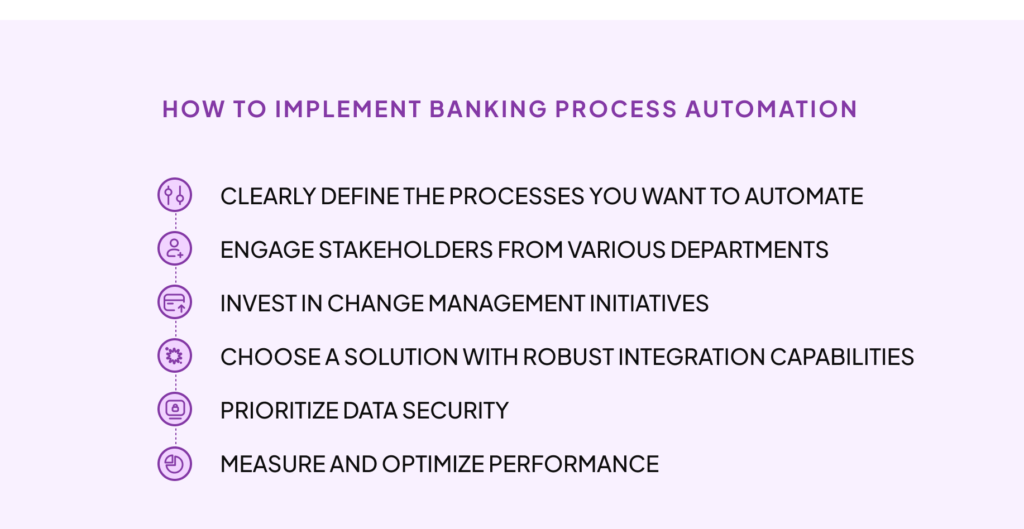Automating your bank’s processes is essential for success in 2025. By automating routine tasks, banks can reduce operational costs, minimize errors, and increase productivity, allowing staff to focus on strategic initiatives.
Banking process automation definition
Banking process automation uses technology to optimize various banking operations, reducing the need for manual intervention. Automating repetitive tasks like data entry, transaction processing, and compliance checks can significantly improve efficiency and accuracy. This enhances the customer experience and allows financial institutions to allocate resources more effectively.
Top three benefits of banking process automation
Implementing process automation in your banking operations changes almost every aspect of how your work gets done. Here are three of the most impactful benefits:
- Reduces operational costs by minimizing the time and labor associated with manual processes.
- Enhances compliance by consistently meeting regulatory requirements, reducing the risk of penalties.
- Improves customer satisfaction through faster service delivery and reduced wait times, leading to increased loyalty and retention.

Common use cases for banking process automation
Common use cases for banking process automation include loan processing, account opening, and transaction monitoring. For example, automating loan processing can streamline the approval workflow, allowing banks to assess applications more quickly and accurately. Similarly, automating account opening simplifies the onboarding process, enabling customers to complete their applications online with ease. By adopting process automation in the banking sector, banks can keep up with industry demands and position themselves as leaders in innovation and customer service.

How does banking process automation work?
Banking process automation enhances the efficiency of various operations through a structured workflow automation process. This involves identifying repetitive tasks, mapping out workflows, and implementing automated solutions. By automating processes such as loan approvals, account management, and compliance checks, banks can minimize human error, expedite service delivery, and improve customer satisfaction.
Key components include workflow management systems, robotic process automation (RPA), and artificial intelligence (AI). Workflow management systems provide a platform for designing, executing, and monitoring automated processes. RPA allows for the automation of rule-based tasks, enabling banks to handle high volumes of transactions accurately and quickly. AI technologies can analyze vast amounts of data to inform decision-making and improve customer interactions.

Integrating banking process automation with existing systems is crucial for seamless operations. This integration allows automated workflows to connect with core banking applications, customer relationship management (CRM) systems, and compliance tools. By leveraging robust integration capabilities, banks can ensure that their automation initiatives align with their existing infrastructure, maintaining data integrity and security.
Choosing the right automation solution
When selecting an automation solution for the banking industry, consider several factors to ensure it aligns with your institution’s goals and operational needs. Assess the scalability of the solution; as your bank grows, your automation needs will evolve. Evaluate the integration capabilities with existing systems to facilitate a smooth transition. User-friendliness is another critical factor, as an intuitive interface will help staff adopt the new technology more rapidly.

Key features and functionalities to look for include workflow automation, robust reporting tools, and compliance tracking capabilities. A solution with advanced analytics can provide valuable insights into operational efficiency, enabling your bank to make data-driven decisions. Ensure the solution supports mobile access, as more banking processes shift to mobile platforms.
Successful implementations of banking process automation can be seen in numerous case studies. For instance, a leading financial institution streamlined its loan processing system, reducing turnaround time and increasing customer satisfaction significantly. By automating repetitive tasks, employees focused on higher-value activities, enhancing service delivery. These examples show the transformative impact of selecting the right automation solution tailored to your specific needs.
Implementing banking process automation
Understanding the complexities and demands of the banking industry, it is crucial to embrace automation for banking to streamline operations, enhance customer experiences, and ensure compliance with regulatory requirements. With a robust suite of tools designed for process automation, banks can reduce manual workloads, increase efficiency, and improve accuracy in their operations.
Automation in banking specifically addresses the unique needs of the sector by offering solutions that facilitate the automation of repetitive tasks, document management, and workflow orchestration. Platforms that integrate seamlessly with existing banking systems allow institutions to automate processes such as loan origination, customer onboarding, compliance reporting, and account management. By using advanced automation solutions, banks can achieve faster turnaround times, lower operational costs, and higher customer satisfaction.
Best practices for successful banking process automation
Implementing banking process automation can significantly improve efficiency and customer satisfaction, but a successful rollout requires careful planning and execution. Start by clearly defining the processes you wish to automate. Engage stakeholders from various departments to gather insights and ensure all perspectives are considered. This collaborative approach helps create an automation strategy that aligns with your bank’s goals.

Common challenges in banking process automation include resistance to change, integration with legacy systems, and data security concerns. To overcome these obstacles, invest in change management initiatives that educate and involve staff in the transition. Selecting automation solutions with robust integration capabilities can ease the migration from existing systems. Prioritizing data security through encryption and compliance measures will also help address concerns about sensitive information.
Once your banking processes are automated, it’s crucial to measure and optimize performance continually. Establish key performance indicators (KPIs) that reflect your automation goals, such as processing time, error rates, and customer satisfaction scores. Regularly analyzing these metrics will highlight areas for improvement and demonstrate the value of your automation efforts to stakeholders. With a commitment to ongoing optimization, your bank can stay ahead of the competition and adapt to evolving customer needs.
Banking process automation before and after
| Before | After |
|---|---|
| Manual data entry errors | Automated data capture |
| High operational costs | Cost reduction via automation |
| Slow invoice processing | Faster processing times |
| Compliance issues | Consistent compliance checks |
| Manual tasks drain resources | Free up resources for strategic work |
Future trends and innovations in banking process automation
The landscape of automation is rapidly evolving in all industries, driven by emerging technologies that are reshaping how financial institutions operate. Artificial Intelligence (AI) and Machine Learning (ML) are at the forefront, enabling banks to automate complex decision-making processes and improve customer experiences. Robotic Process Automation (RPA) is also gaining traction, streamlining repetitive tasks and reducing operational costs, allowing human resources to focus on more strategic initiatives.
Looking ahead, predictions for the future of banking process automation suggest increased integration of blockchain technology, which promises to enhance security and transparency in transactions. Additionally, the rise of low-code platforms will empower banks to quickly adapt their processes to meet changing regulations and customer demands without extensive IT intervention. As these technologies mature, we can expect a more interconnected financial ecosystem where automation plays a pivotal role in driving efficiency and innovation.
Opportunities for continued optimization and growth in banking process automation will continue to increase. By leveraging advanced analytics, banks can gain deeper insights into customer behavior and preferences, allowing for more personalized service offerings. As automation becomes more sophisticated, the potential for enhancing compliance and risk management processes will also expand, ensuring that banks remain resilient in a dynamic regulatory environment. Embracing these trends will not only position financial institutions for success but also improve the banking experience for customers worldwide.
Banking automation FAQ
What is banking process automation? Banking process automation uses technology to streamline and optimize banking operations by reducing manual intervention.
What are the benefits of banking process automation? Benefits include reduced operational costs, enhanced compliance, improved customer satisfaction, and increased productivity.
Which banking processes can be automated? Commonly automated processes include loan processing, account opening, transaction monitoring, and compliance checks.
How does automation improve compliance? Automation ensures regulatory requirements are consistently met, reducing the risk of penalties and enhancing accuracy.
What should be considered when choosing an automation solution? Consider scalability, integration capabilities, user-friendliness, and advanced features like analytics and mobile access.
